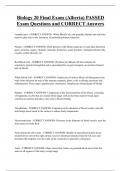Biology 20 Final Exam (Alberta) PASSED
Exam Questions and CORRECT Answers
Lymphocytes - CORRECT ANSWER- White Blood Cell, non granular, thymus and red bone
marrow, play role in the formation of antibodies(defense function)
Plasma - CORRECT ANSWER- Fluid portion of the blood, made up of water plus dissolved
gases, proteins, sugars, vitamins, minerals, hormones, waste products. Transports blood cells,
oxygen, carbon dioxide, etc.
Red Blood Cell - CORRECT ANSWER- (Erythrocyte) Blood cell that contains the
respiratory protein hemoglobin and is specialized for oxygen transport, no nucleus (formed
part of blood)
White Blood Cell - CORRECT ANSWER- (leukocyte) Colorless blood cell that protects the
body from infection by way of the immune response, plays a role in allergic reactions and
inflammation. Three types: granulocytes, monocytes, lymphocytes (formed part of blood)
Platelet - CORRECT ANSWER- Component of the formed portion of the blood, consisting
of fragments of cells that are created when larger cells in the bone marrow break apart,
contains no nucleus and plays a key role in blood clotting
Vasodilation - CORRECT ANSWER- Expansion in the diameter of blood vessels; near the
skin brings more blood to the surface to reduce body temperature
Vasoconstriction - CORRECT ANSWER- Decrease in the diameter of blood vessels; near the
skin conserves body heat
Atrioventricular (AV) node - CORRECT ANSWER- Bundle of specialized muscle tissue
located int he wall of the right atrium; receives electrical stimulus from the SA nose and
transmits this impulse over the walls of the ventricles to start their contraction
Aorta - CORRECT ANSWER- Major artery that carries oxygenated blood away from the
heart to all regions of the body, except lungs
,Tricuspid Valve - CORRECT ANSWER- (atrioventricular) Separates the right atria and
ventricle, 3 flaps
Bicuspid Valve - CORRECT ANSWER- (atrioventricular) Separates the left atria and
ventricle, 2 flaps
Semilunar Valves - CORRECT ANSWER- (Aortic + Pulmonary) Look like half moons, keep
the blood when it is pumped to the lungs and body from leaking back into the heart
Circulatory System - CORRECT ANSWER- System of vessels that transports blood, the cells
and substances suspended and dissolved in blood throughout the body. Links all systems;
transports oxygen, waste, nutrients, hormones, medicine, enzymes, etc. Regulates internal
temperature, protects against blood loss from injury, disease causing microbes, or toxic
substances introduced to the body.
Pulmonary Pathway - CORRECT ANSWER- Heart to lungs and back to the heart
Systemic Pathway - CORRECT ANSWER- Heart to body and back to the heart
Coronary Pathway - CORRECT ANSWER- Heart to heart vessels and back to the heart
Heart's Functions - CORRECT ANSWER- Pump blood through the body, keep oxygen rich
blood separated from oxygen poor blood, ensure that blood flows only in one direction
through the body
Capillaries - CORRECT ANSWER- The smallest blood vessel; gases and other substances
are exchanged between the circulatory system and body tissues across one cell capillary wall
Sinoatrial Node - CORRECT ANSWER- Bundle of specialized muscle tissue located in the
wall of the right atrium of the mammalian heart; generates an electrical impulse that
stimulates cardiac muscle fibers to contract and relax rhythmically, producing a regular heart
beat (organic pacemaker)
, Cardiac Output - CORRECT ANSWER- Cardiac output = heart rate x stroke volume
(mL/min); average output = total volume of blood that circulates through the heart once per
minute
Atherosclerosis - CORRECT ANSWER- Build up of plaque (fatty deposits, calcium, and
fibrous tissues) on the inside of artery walls. Blood flow is decreased and blood pressure
increased; Angioplasty and coronary bypass
Blood - CORRECT ANSWER- Tissue with a solid and fluid portion
Aldosterone - CORRECT ANSWER- Type of hormone secreted by the adrenal cortex;
stimulates the distal tubule and collecting duct of the kidneys to increase the absorption of
sodium into the bloodstream, followed by the passive absorption of water and chloride
ADH - CORRECT ANSWER- Hormone regulated by the hypothalamus and released by the
pituitary gland that increases the permeability of the distal tubule and collecting duct in the
nephrons of the kidneys, allowing more water to be reabsorbed into the blood from the filtrate
Collecting Duct - CORRECT ANSWER- Pipe-like channel arising from the tubule connected
to the bowman's capsule in the nephron; functions as a water conservation device,
reabsorbing water from the filtration in the nephron
Renal Artery - CORRECT ANSWER- Blood vessel that originates from the aorta and
delivers blood to the kidneys; splits into the glomerulus within the bowman's capsule of the
nephron
Renal Vein - CORRECT ANSWER- Blood Vessel that drains from the kidney; returns to the
body the solutes and water reabsorbed by the kidney
Proximal Convoluted Tubule - CORRECT ANSWER- Tubular portion of the nephron that
lies between the bowman's capsule and the loop of henle; main function is re absorption of
water and solutes, as well as secretion of hydrogen ions
Loop of Henle - CORRECT ANSWER- Tubular portion of the nephron that lies between
proximal and distal tubule; main function is re absorption of water and ions




